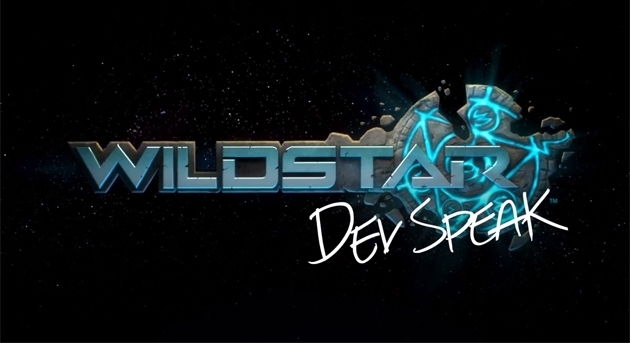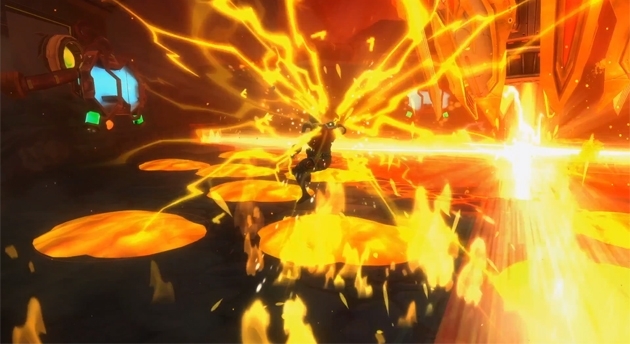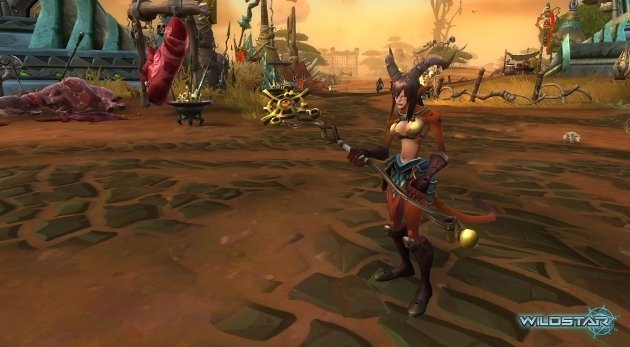WildStar: More on Movement
With Carbine releasing a new Movement DevSpeak video, we interview Lead Combat Systems Designer Chris Lynch, and Lead Class Designer Hugh Shelton about this key aspect.

Movement is the oxygen of a video game. When the controls are perfect the keyboard and mouse become subconscious extensions of our self, translating commands to our avatars at the speed of thought. When they go wrong, playing becomes a frustrating battle that can leave you feeling locked out of the game.
In an MMO, moving around is the single thing you’ll spend most of your time doing, as our own Bill "Lethality" Leonard discussed following his visit to WildStar's US Arkship event. Whether it’s dodging lasers from a crazed killer robot, chasing after a mining node that’s grown legs and is sprinting away, or just strolling around and enjoying the scenery, you’ll be constantly racking up the miles. Which is why, for a game like WildStar, movement is particularly important. So important, in fact, that they’ve devoted an entire DevSpeak video to the subject.
My interest piqued, I was eager to find out more about this aspect of WildStar’s foundations. Carbine Studios kindly responded by giving me the chance to speak to Lead Combat Systems Designer Chris Lynch, and Lead Class Designer Hugh Shelton. Together, these Men of Movement are responsible for most of the actions you’ll be performing with your character in-game.
Gareth Harmer: To kick things off, what made you decide to focus on Movement in a DevSpeak video?
Chris Lynch: We think one of the key things to a game is actually movement, when you start with combat. We say this because a lot of our abilities are aiming based, and a lot of our combat is movement based, so if we don’t teach you what’s different about our movement, it’s going to be hard for the players to just learn and pick up right away.
Hugh Shelton: It’s just one of those things where I think we took for granted how big movement played in our game compared to other MMOs, where a lot of times things feel really stationary, or movement might feel a little blocky or whatever. We feel like WildStar’s movement is really freeform, moving all over the place. You’re encouraged to move in combat, we develop our boss encounters to make you have to move around, and we give you the tools you need to do that.
How do you ensure WildStar has that unique feel?
Lynch: We have a lot that makes ourselves different. One of the things I really enjoy about our game, that is different from other games that I’ve played, is the freeform targeting, and it does slide back into movement. All of the classes that I play, to use them the most effectively you need to line up the shots.
Let’s talk about the Esper: they have a long rectangle shaped telegraph or freeform spell. And aiming that spell in the game, it just feels really rewarding to have to move around. I have multiple targets I’m aiming at, and if I move just right, I’m actually aiming that spell to hit multiple targets, as opposed to just standing still, and just tab targeting and dealing damage to single targets.
You feel rewarded for moving around and aiming your spells correctly because you’re getting the most out of your spells. We don’t explicitly tell you to do this, it just starts naturally happening because most players are like “Hey, if I line up this spell this way, I’m going to hit multiple targets.” And I’ve found that it just becomes addictive - I will move around and try to get as many enemies into my freeform targeting decal as possible.
Shelton: We take those fundamentals of movement being more advanced than some of the other games you may have played, and we take the classes with their abilities and the freeform targeting, and then that’s used throughout the rest of the game. And we have so many different features that a lot of MMOs aren’t able to launch with, so you see all this stuff being used everywhere: you see it being used in housing, you see it being used in dungeons, you see it being used in some of the other stuff that we haven’t talked about yet.

After playing WildStar at Arkship EU, movement already feels slick and natural. How long did you spend developing and testing it?
Lynch: We’ve been working on movement for many years. We have a passionate art team that is very integrated into our combat team - we are a cross-discipline team, and we all work side-by-side. And they bring a lot of experience from other games and just personal play styles. They wanted to make sure that our combat was very, very fluid. They had a big, integral piece in that.
I’d say artists helped us get there over the last couple of years just to make sure it’s fluid and looked as good as possible. Obviously, if you look at our animations, they’re very fluid and they look like they belong; the movement goes along with that. Honestly, the artists really helped us to bring it to the level that it is today. That’s why it feels so smooth.
Shelton: From my perspective, I joined the team about a year ago, and I would say that the movement already felt really fluid when I joined the team. From there we’ve just been making improvements on it up to this point, just tweaking and tuning things. Like making sure the dash timing feels good for everybody, where you’re not accidentally dashing around. And adjusting the turn rate so that, when you’re lining up a shot, you’re not going too far - that kind of stuff. Just fine-tuning it over the past year.
Lynch: There’s still room to improve, and we’re working on that. We just started beta a little bit ago, and we’re getting lots of feedback from there. We’ll be fine tuning it up until… I want to say up until launch. We just want to make it feel better and better.
How does your own fine-tuning compare to player tuning for things like mouse sensitivity?
Shelton: So far we haven’t given a lot of options for players to tune the sensitivity of different things. We’ve been trying to hit the baseline for those, but we’re totally open to adjusting things as we move forward, just based off player feedback. If we’re getting responses from players where the controls don’t feel right for them, then we will end up making options for those players.
Lynch: A lot of these are just console commands that we’re using. Essentially it’s what we would provide to the players in the future, so the options are already there for the most part - it’s just exposing them to the client so the players have easy access to it. If the players are requesting certain things or we find that different people within the company want to play different styles, we’ll probably end up opening those options to the players as well.
One example that Hugh was talking about was the actual aiming of a spell. The aiming turn rate of your character is actually a console command that we might end up exposing to the player just to make it so that the sensitivity is to the style that you like.

What came first: putting in a particularly cool movement style, or wanting a combat style and needing the movement?
Lynch: The way we look at things is like a puzzle. We created telegraphs around two and a half years ago, and the puzzle there is that the red decal always means bad. It’s the same clear message to the player – get out of the red. We always want to provide the player with the necessary solutions to the puzzle, so at the same time we’re like “Well, let’s give them dash.” They were conceived around the same time, and we just evolved them to the point they are today. Basically chicken and egg: they came at the same time for us.
Shelton: Chris mentioned it earlier that the artists played a big role in how our movement feels. Some of the stuff like double-jump, I wasn’t here when they added it to the game, but I know that came up from artists and different individuals - it wasn’t necessarily the design team that wanted to add these different elements to the game.
Once we had all these tools together we were able to just keep going, just push forward. When I joined the team we were able to just take the classes that we had and continue to improve upon them, knowing that we had these other movement tools.





